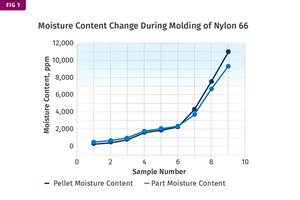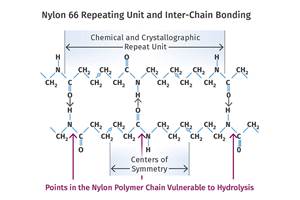Molding with Nylon: Tips & Tricks
Remember to consider shrinkage, gassing, and moisture when molding this versatile, but at times vexing, engineering plastic.
One of the trickiest materials to mold with is nylon. The material itself has great molded-in properties, such as strength and, when used properly, visual aesthetics. Using the material itself, however can sometimes require a strong processing approach to prevent variations and defects. Nylon processing does not have to be frustrating, and by applying some basic molding rules, you can prevent processing headaches.
This article will address some common problems that occur in nylon molding. It will identify many of the normal molding conditions that are common with this material, as well as provide some insight into processing approaches that can help to reduce, and even eliminate scrap events.
Gassing
One of the most common problems with nylon molding is gassing. Gas causes such defects as shorts/unfill, poor/chalky appearance and inadequte filling in of rib/detail areas.
There are several reasons that gassing can occur. First, the higher the barrel temperature is, the more gas will be produced. There are things to consider when trying to correct a gassing condition. First would be the initial process set up. Always start at the lower end of the melt window as established by the material supplier. A processor’s goal should always be to keep the heats as low as possible. Lower temperatures reduce gas but, it should also be noted that a temperature that is too low can reduce flow-front performance leading to shear and burns or unfill. Take the time to find the appropriate temperature that allows nice flow with reduced gassing.
In addition, verify that gas has ample opportunity for escape through venting. Poor venting can lead to major headaches. End-of-fill venting is imperative to assure process control. When vented pins are used, the mold will need to be analyzed historically to develop a strong preventative maintenance approach. It is also important to monitor gassed vents, to determine the appropriate mold cleaning schedule. The general rule is that a mold running nylon should be cleaned once per shift, but some might require more frequent servicing.
Barrel throughput is another variable that can be considered when gassing is an issue. The longer nylon stays in the barrel, the more prone it is to producing gas. In some cases, the process might require lower temperatures in the rear zones of the barrel. It can become a tricky situation, however. If barrel temperatures in rear are too low, you can expect increased shear in the metering section. This of course can cause splay. Use care when reducing barrel temperature, while maintaining proper shear to provide proper melt and mixing.
Moisture
Moisture is another key to nylon production. Poor drying can cause gassing and other potential scrap-producing defects. It is important to note that of all materials, nylon is the most hygroscopic and can quickly take in moisture.
When starting a press, it is good practice to drain at least 25 pounds material from the dryer cone to assure that the material being introduced to the loader is sufficiently dry. In addition, make sure the loader line and loader receptacle have been cleared of material that has sat for any time period over 5 minutes. Purge the barrel amply, to allow the barrel time to heat soak. Learn what appearance the purge puddle should have to identify that the material is ready for injection.
In addition, it is important to note that nylon is not only affected by poor drying/ moisture conditions. Over drying can also lead to multiple defect conditions. Pay attention to long-term drying occurrences, and bank the dryer appropriately to prevent over drying. Material that is overbaked tends to take on a yellowed appearance. If defects such as splay or poor appearance occur, dry time and dryer heat should be reviewed and considered as suspect.
Shrinkage
Nylon is one material that is more prone to shrinkage. This can affect dimensional properties. In addition, many nylons are semi-crystalline. Increased or poor shrinkage can result in reduced strength, poor color and warp. Shrinkage needs to be controlled through barrel and mold temperatures. It is important to remember that any added heat increases cycle time. In some cases, that increase is essential to improve part properties. It is also important to note that although the general rule that part shrinkage is achieved within one hour, there are occasions where nylon stasis might require up to 24 hours for shrinkage to be complete.
Nylon can be a very temperamental material, leading to frustration, high scrap and low efficiencies. With the proper handling, care and approach nylon is capable of the same consistencies of materials that require less maintenance. Taking a strong approach through tool design, proper material handling procedures and concentrated processing set up are the best ways to assure successful nylon molding and a company’s success and profitability.
ABOUT THE AUTHOR: Garrett MacKenzie is the owner and editor of www.plastic411.com. MacKenzie has held engineering/management positions for 16 years, and his plastics career spans more than three decades. He currently provides training in plastics injection molding. His next training event is a Scientific Molding Work Shop, to be held in Dalton, GA from March 24-25, 2018. For more information about the event, visit the plastic411.com website. He can also be reached at: training@plastic411.com.
Related Content
What's the Allowable Moisture Content in Nylons? It Depends: Part 2
Operating within guidelines from material suppliers can produce levels of polymer degradation. Get around it with better control over either the temperature of the melt or the barrel residence time.
Read MoreGeneral Polymers Thermoplastics to Further Expand Distribution Business
NPE2024: Following the company’s recent partnership buyout, new North American geographic territories are in its sight.
Read MoreWhat is the Allowable Moisture Content in Nylons? It Depends (Part 1)
A lot of the nylon that is processed is filled or reinforced, but the data sheets generally don’t account for this, making drying recommendations confusing. Here’s what you need to know.
Read MoreLanxess and DSM Engineering Materials Venture Launched as ‘Envalior’
This new global engineering materials contender combines Lanxess’ high-performance materials business with DSM’s engineering materials business.
Read MoreRead Next
See Recyclers Close the Loop on Trade Show Production Scrap at NPE2024
A collaboration between show organizer PLASTICS, recycler CPR and size reduction experts WEIMA and Conair recovered and recycled all production scrap at NPE2024.
Read MoreFor PLASTICS' CEO Seaholm, NPE to Shine Light on Sustainability Successes
With advocacy, communication and sustainability as three main pillars, Seaholm leads a trade association to NPE that ‘is more active today than we have ever been.’
Read MorePeople 4.0 – How to Get Buy-In from Your Staff for Industry 4.0 Systems
Implementing a production monitoring system as the foundation of a ‘smart factory’ is about integrating people with new technology as much as it is about integrating machines and computers. Here are tips from a company that has gone through the process.
Read More

























